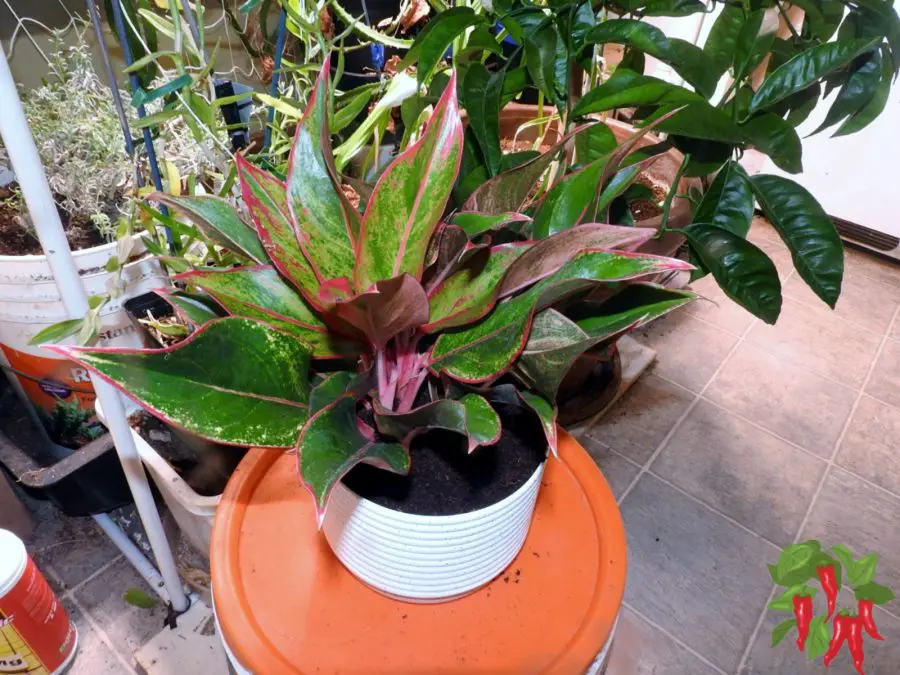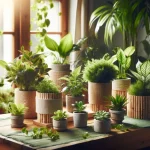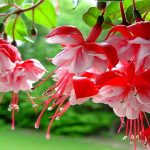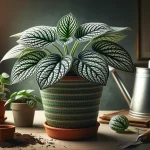This post may contain affiliate links. If you buy something from one of our links we may earn a commission. Thanks

Red Aglaonema care doesn’t have to be complicated. Struggling to keep your houseplants alive? These vibrant beauties are here to save the day!
With their striking foliage and easy-going nature, Red Aglaonemas are the perfect solution for plant lovers of all skill levels.
Red Aglaonema Care Key Takeaways
- Red Aglaonema care is simple and rewarding.
- These low-maintenance houseplants thrive in bright, indirect light and prefer well-draining soil.
- Water when the top inch of soil feels dry, maintain temperatures between 60-75°F, and provide moderate humidity.
- With proper care, Red Aglaonemas will add vibrant color to your home for years.
Red Aglaonema Care: Your Guide to Growing Stunning Chinese Evergreens
 Costa Farms Chinese Evergreen, Red, Easy to Grow Live Indoor Plant Aglaonema, Houseplant Potted in Indoors Garden Plant Pot, Potting Soil Mix, Gift for New Home, Office, or Home Décor, 1-2 Feet Tall
Costa Farms Chinese Evergreen, Red, Easy to Grow Live Indoor Plant Aglaonema, Houseplant Potted in Indoors Garden Plant Pot, Potting Soil Mix, Gift for New Home, Office, or Home Décor, 1-2 Feet Tall
Welcome to the wonderful world of Red Aglaonemas! These eye-catching houseplants, also known as Chinese Evergreens, are gaining popularity among plant enthusiasts for good reason.
With their vibrant red and green foliage, they’re sure to add a pop of color to any indoor space.
But what makes them truly special is their adaptability and ease of care, making them perfect for both beginners and seasoned plant parents alike.
Overview Of Red Aglaonemas
Red Aglaonemas, scientifically known as Aglaonema commutatum, are tropical plants native to Southeast Asia.
They belong to the Araceae family and are prized for their striking foliage. The “red” in their name comes from the various shades of red, pink, and burgundy that adorn their leaves, often contrasting beautifully with deep greens.
Aglaonema commutatum, commonly called Chinese evergreen, is an evergreen perennial that generally resembles dieffenbachia (dumb cane) in appearance. It typically grows to 20” tall. Thick, elliptic to lance-shaped, dark green leaves (to 4-8” long and 2-3” wide) with attractive silver-gray blotches on erect, sometimes branched stems.
As a houseplant, it rarely flowers. Each axillary flower (typical arum family) features a small creamy white spadix enclosed by a pale green spathe, usually in late summer to early fall. Clusters of red berries follow the flowers. Missouri Botanical Garden
Key Characteristics and Appeal
What sets Red Aglaonemas apart is their stunning variety of leaf patterns and colors. The Aglaonema Siam Aurora, for example, features dark green leaves with bright pink veins and edges.
These plants are not only visually appealing but also incredibly versatile. They can thrive in a range of indoor conditions, making them an excellent choice for offices, homes, and even low-light environments.
Toxicity: A Word of Caution
While Red Aglaonemas are beloved for their beauty and easy care, it’s important to note that they do come with a potential risk:
All parts of Aglaonema plants contain calcium oxalate crystals, which can be toxic if ingested.
This makes them potentially harmful to pets and small children who might be tempted to chew on the leaves.
Symptoms of ingestion can include irritation of the mouth and throat, difficulty swallowing, and in severe cases, swelling of the airways.
If you have curious pets or young children, it’s best to keep your Red Aglaonema out of reach or consider opting for non-toxic alternatives.
Always prioritize the safety of your household members when choosing houseplants.
Aglaonema Indoor Plant Benefits
Let’s talk about why Red Aglaonemas are more than just pretty faces in your home.
These plants aren’t just sitting there looking good (although they definitely do that!).
They’re actually hard at work, improving your indoor environment in ways you might not even realize.
From cleaning the air to boosting your mood, Red Aglaonemas are the multitasking superstars of the plant world.
Air-purifying Qualities
One of the most significant benefits of Red Aglaonemas is their air-purifying ability. These plants are known to filter out common indoor pollutants like benzene, formaldehyde, and other volatile organic compounds (VOCs).
By absorbing these harmful substances through their leaves and roots, Red Aglaonemas help create a cleaner, healthier living environment.
Mental and emotional health benefits
Having Red Aglaonemas in your space can do wonders for your mental well-being.
The act of caring for plants has been shown to reduce stress, increase feelings of calm, and even improve concentration.
Plus, the vibrant colors of Red Aglaonemas can brighten your mood and add a touch of nature to your indoor environment, which is especially beneficial if you’re stuck inside for long periods.
Aesthetic and interior decoration advantages
From a design perspective, Red Aglaonemas are incredibly versatile. Their compact size and striking foliage make them perfect for adding a pop of color to shelves, desks, or as standalone floor plants.
They can complement various interior styles, from modern minimalist to eclectic bohemian.
Plus, their ability to thrive in low-light conditions means you can brighten up even the darkest corners of your home.
Feng Shui and Aglaonemas: Cultivating Prosperity and Harmony
In the ancient practice of Feng Shui, Aglaonemas hold a special place. These plants are not just beautiful additions to your decor; they’re also believed to bring positive energy and good fortune into your space. Let’s delve into the Feng Shui significance of Aglaonemas:
Symbol of Good Luck
In Feng Shui, Aglaonemas are often referred to as “Lucky Plants” or “Chinese Evergreens.” Their lush, vibrant foliage is thought to represent vitality and growth, attracting positive chi (energy) to your home or office.
Prosperity and Wealth
The rich green color of Aglaonema leaves is associated with wealth and prosperity in Feng Shui.
Red varieties, like our beloved Red Aglaonema, are particularly auspicious as red is the color of good fortune in Chinese culture.
Placement for Maximum Benefit
To harness the positive energy of your Aglaonema:
- Southeast Corner: Place your plant in the southeast corner of your home or office to enhance wealth and abundance.
- East Area: The east area represents health and family. An Aglaonema here can promote family harmony and wellbeing.
- North Section: In offices, placing an Aglaonema in the north section is believed to support career growth.
Cleansing Energy
Aglaonemas are thought to have air-purifying properties, which aligns with the Feng Shui principle of creating a clean, harmonious environment. They’re believed to absorb negative energy and promote a sense of calm and balance.
Growth and Nurturing
The act of caring for your Aglaonema is also significant in Feng Shui. As you nurture your plant, you’re symbolically cultivating growth and abundance in your own life.
Remember, while Feng Shui can be a fun and meaningful way to arrange your space, the most important thing is that you enjoy your plants and feel good in your environment.
Whether you’re a Feng Shui enthusiast or just love the look of Aglaonemas, these versatile plants are sure to bring a touch of natural beauty and positive energy to your home or office.
Aglaonema Plant Care Tips
Alright, let’s get down to the nitty-gritty of Red Aglaonema care. Don’t worry, it’s not rocket science!
These plants are pretty chill when it comes to their needs, but there are a few key things to keep in mind to help them thrive.
Whether you’re a first-time plant parent or a seasoned pro, these tips will help you keep your Red Aglaonema looking its best.
General care requirements
Red Aglaonemas are generally low-maintenance plants. They prefer bright, indirect light but can tolerate lower light conditions.
Water them when the top inch of soil feels dry, and make sure they’re in well-draining soil.
These plants enjoy moderate humidity and temperatures between 60-75°F (15-24°C).
Common mistakes to avoid
One of the most common mistakes is overwatering. Red Aglaonemas are more tolerant of underwatering than overwatering, so err on the side of caution.
Also, avoid placing them in direct sunlight, as this can scorch their leaves. Lastly, don’t forget to dust their leaves occasionally to keep them looking fresh and allow for better photosynthesis.
Seasonal care adjustments
During the growing season (spring and summer), you might need to water your Red Aglaonema more frequently and provide a bit more humidity.
In winter, reduce watering and avoid cold drafts. It’s also a good idea to hold off on fertilizing during the colder months when growth naturally slows down.
Light Requirements
Let’s shed some light on the subject of, well, light! Red Aglaonemas are pretty flexible when it comes to their lighting needs, which is part of what makes them such great indoor plants.
But to keep them looking their best and growing strong, it’s important to understand what kind of light they really love.
Ideal lighting conditions
Red Aglaonemas thrive in bright, indirect light. This means they love a spot near a window with filtered sunlight, perhaps through a sheer curtain.
They can also do well under fluorescent lights, making them perfect for offices or rooms without much natural light.
Tolerance to low light vs. bright indirect light
One of the great things about Red Aglaonemas is their adaptability to different light conditions.
They can tolerate low light areas, although their growth may slow down and their colors might not be as vibrant.
In bright indirect light, they’ll grow faster and maintain their beautiful coloration.
Effects of too much or too little light
Too much direct sunlight can scorch the leaves of your Red Aglaonema, causing brown spots or faded colors.
On the other hand, too little light can lead to leggy growth, loss of variegation, and smaller leaves.
If you notice any of these signs, try adjusting your plant’s location to find the sweet spot.
Soil and Watering
Water you waiting for? Let’s dive into the world of soil and watering for Red Aglaonemas!
Getting these two elements right is crucial for keeping your plant happy and healthy. Don’t worry, though – once you understand the basics, it’s smooth sailing (or should we say, smooth watering?).
Best soil composition ( coco coir or peat-based, well-draining soil)
Red Aglaonemas prefer a well-draining, peat-based potting mix. A good ratio to aim for is two parts peat moss, one part perlite, and one part coarse sand. This mixture provides the right balance of moisture retention and drainage that these plants love.
Coco Coir and Perlite Soil Mix
This is a great mix for Red Aglaonemas. A good ratio is 25-33% perlite to coco coir. It holds water well and is fast draining. It is more environmentally sustainable than peat-based soil mixes.
How and when to water (drench-and-dry method)
The best watering method for Red Aglaonemas is the “drench-and-dry” approach.
Water thoroughly until water runs out of the drainage holes, then allow the top inch of soil to dry out before watering again.
This usually means watering once every 7-10 days, but always check the soil moisture first.
Importance of avoiding overwatering
Overwatering is the number one killer of Red Aglaonemas. These plants are more tolerant of underwatering than overwatering.
Soggy soil can lead to root rot, which can quickly kill your plant. If you’re unsure, it’s better to wait an extra day before watering.
Temperature and Humidity
Time to talk temperature and humidity! Red Aglaonemas might hail from tropical regions, but don’t worry – they’re not divas when it comes to climate.
However, getting these conditions right can make the difference between a good-looking plant and a truly thriving one. Let’s break it down!
Optimal temperature range (60-75°F)
Red Aglaonemas are comfortable in average room temperatures, ideally between 60-75°F (15-24°C).
They can tolerate temperatures as low as 55°F (13°C), but prolonged exposure to cold can damage the plant.
Avoid placing them near drafty windows or air conditioning vents.
Humidity preferences and how to manage them indoors
These plants prefer moderate to high humidity, around 50-60%. While they can tolerate average indoor humidity levels, they’ll truly thrive with a bit more moisture in the air.
You can increase humidity by misting the leaves, using a pebble tray filled with water, or placing a humidifier nearby.
Tips for maintaining humidity in dry climates
If you live in a dry climate, don’t fret! There are several ways to boost humidity for your Red Aglaonema.
Grouping plants together can create a microclimate with higher humidity. You can also place your plant in naturally humid areas of your home, like bathrooms or kitchens, as long as they still get enough light.
Red Aglaonema Propagation
Ready to multiply your Red Aglaonema collection? Propagation is like plant magic – it’s a way to create new plants from your existing ones.
Not only is it a fun project, but it’s also a great way to share the love with fellow plant enthusiasts. Let’s explore how you can become a Red Aglaonema propagation pro!
Methods: stem cuttings, root division
There are two main methods for propagating Red Aglaonemas: stem cuttings and root division.
Stem cuttings involve taking a healthy stem with a few leaves and rooting it in water or soil.
Root division is done when repotting by carefully separating the plant into smaller sections, each with its own roots and stems.
Step-by-step process for each method
For stem cuttings:
1. Cut a healthy stem with at least 2-3 leaves.
2. Remove the lower leaves, leaving the top ones intact.
3. Place the cutting in water or moist soil.
4. Keep in a warm, bright spot out of direct sunlight.
5. Roots should develop in 2-3 weeks.
For root division:
1. Remove the plant from its pot.
2. Gently separate the roots, identifying natural divisions.
3. Ensure each division has a good root system and some leaves.
4. Pot each division in fresh soil.
5. Water thoroughly and place in a suitable location.
Best time of year for propagation
The best time to propagate Red Aglaonemas is during the growing season, typically spring or early summer. This gives the new plants plenty of time to establish themselves before the slower winter growth period.
How to Make Aglaonema Bushy
Want your Red Aglaonema to be the fullest, bushiest plant on the block? You’re in the right place!
While these plants naturally have a compact growth habit, there are some tricks you can use to encourage even fuller, more lush growth.
Let’s dive into how you can turn your Red Aglaonema into a leafy showstopper!
Pruning techniques to encourage dense growth
Regular pruning is key to promoting bushy growth in Red Aglaonemas. Remove any yellow or damaged leaves to redirect the plant’s energy to new growth.
You can also prune the tips of stems to encourage branching, which will result in a fuller appearance.
Pinching and rotating for even development
Pinching off the growing tips of your Red Aglaonema can stimulate the growth of new stems, leading to a bushier plant.
Remember to rotate your plant regularly (about a quarter turn each week) to ensure all sides receive equal light, promoting even growth.
Common issues with leggy growth
If your Red Aglaonema is becoming leggy, it’s likely not getting enough light. Move it to a brighter location (but still out of direct sunlight) and consider pruning the longest stems to encourage fuller growth from the base.
Ongoing Maintenance
Congratulations! You’ve mastered the basics of Red Aglaonema care. But the journey doesn’t stop here.
To keep your plant looking its best year after year, there are a few ongoing maintenance tasks you’ll want to keep in mind.
Don’t worry, though – these tasks are simple and won’t take up much of your time.
Let’s look at how you can keep your Red Aglaonema in tip-top shape for the long haul.
Pruning dead or yellow leaves
Regularly remove any dead, yellowing, or damaged leaves. This not only keeps your plant looking tidy but also prevents potential disease spread and encourages new growth.
Use clean, sharp scissors or pruning shears to make clean cuts close to the main stem.
Repotting guidelines (every 2-3 years)
Red Aglaonemas typically need repotting every 2-3 years or when they outgrow their current pot.
Choose a pot that’s 1-2 inches larger in diameter than the current one. The best time to repot is in spring or early summer when the plant is actively growing.
Pest control: common pests and treatment options
While Red Aglaonemas are relatively pest-resistant, they can occasionally face issues with spider mites, mealybugs, or scale insects.
Regularly inspect your plant for signs of pests. If you spot any, treat with insecticidal soap or neem oil. For severe infestations, you may need to isolate the plant and use a stronger pesticide.
Seasonal Care for Aglaonemas
While Red Aglaonemas are known for their easy-going nature, adjusting your care routine with the seasons can help your plant thrive year-round. Let’s break down what your Aglaonema needs as the seasons change:
Spring and Summer Care
As the days get longer and temperatures rise, your Red Aglaonema will enter its active growing phase. Here’s how to support it:
- Watering: Increase watering frequency as the plant uses more water. Always check the soil moisture first, but you might find yourself watering more often.
- Fertilizing: Start a regular fertilizing schedule. Use a balanced, water-soluble fertilizer at half strength every 4-6 weeks.
- Light: Your plant can handle a bit more light during this time. If you’ve had it in a low-light spot, consider moving it to a brighter location (still avoiding direct sunlight).
- Humidity: With warmer temperatures, you might need to boost humidity. Consider misting your plant or using a pebble tray.
- Pruning and Shaping: This is the best time to prune your plant to encourage bushy growth.
Fall and Winter Care
As growth slows down in the cooler months, your Red Aglaonema’s needs will change:
- Watering: Reduce watering frequency. The soil will take longer to dry out, so be extra vigilant about overwatering.
- Fertilizing: Stop fertilizing or reduce to once every 2-3 months at most. The plant doesn’t need as many nutrients during its dormant period.
- Light: If you live in an area with significantly shorter days in winter, you might need to move your plant closer to a light source.
- Temperature: Keep your Aglaonema away from cold drafts and heating vents. Sudden temperature changes can stress the plant.
- Humidity: Indoor heating can dry out the air, so you might need to increase humidity measures in winter.
- Cleaning: Take time to dust the leaves regularly. Clean leaves can better absorb the limited winter light.
Remember, these are general guidelines. Your specific care routine may vary depending on your home’s conditions and your plant’s individual needs.
By paying attention to your Red Aglaonema and adjusting care seasonally, you’ll be rewarded with a healthy, vibrant plant all year long!
Chinese Evergreen Varieties: A Rainbow of Aglaonemas
While Red Aglaonemas have stolen our hearts, the world of Chinese Evergreens is vast and colorful. Let’s explore some stunning varieties that might just become your next plant obsession:
Silver Bay
The Aglaonema ‘Silver Bay’ is a show-stopper with its silvery-green leaves patterned with dark green edges. It’s perfect for brightening up low-light corners and adds a touch of elegance to any space.
Pink Dalmatian
True to its name, the ‘Pink Dalmatian’ variety boasts green leaves speckled with pink spots, creating a whimsical, confetti-like appearance. It’s a fun addition to any plant collection and sure to spark conversation.
Emerald Bay
For those who love a classic look, the ‘Emerald Bay’ offers lush, dark green leaves with silver-gray streaks. It’s a hardy variety that can tolerate lower light conditions well.
Siam Aurora
The ‘Siam Aurora’ is similar to our beloved Red Aglaonema, featuring dark green leaves with vibrant pink veins and edges. It’s a stunning plant that adds a tropical flair to any room.
Maria
The ‘Maria’ variety is known for its tolerance to low light. It has deep green leaves with silver-gray central patches, making it a great choice for offices or darker corners of your home.
Stripes
As the name suggests, the Aglaonema ‘Stripes’ features elongated leaves with alternating bands of dark and light green. It’s a unique variety that adds visual interest and texture to your plant display.
Each of these varieties has its own unique care requirements, but they all share the general hardiness and adaptability that makes Aglaonemas so popular.
Whether you prefer bold colors or subtle patterns, there’s an Aglaonema variety to suit every taste and environment.
Red Aglaonema Care FAQs
Still have questions about Red Aglaonema care? You’re not alone! Here are some of the most frequently asked questions about these stunning plants.
Whether you’re a new plant parent or just looking to up your Aglaonema game, these answers should help clear things up.
Q: How do you care for red Aglaonema indoors?
A: Red Aglaonemas thrive in bright, indirect light. Water when the top inch of soil is dry, use well-draining soil, and maintain temperatures between 60-75°F. Provide moderate humidity and fertilize monthly during the growing season.
Q: Where is the best place to put Aglaonema?
A: The best spot for an Aglaonema is near a north or east-facing window where it receives bright, indirect light. They can also do well under fluorescent lights, making them great for offices or rooms with limited natural light.
Q: Does Aglaonema need sunlight?
A: Aglaonemas prefer bright, indirect light but can tolerate low light conditions. Direct sunlight can scorch their leaves, so it’s best to avoid placing them in direct sun.
Q: How often should I water my Aglaonema?
A: Water your Aglaonema when the top inch of soil feels dry. This usually means watering once every 7-10 days, but always check the soil moisture first. Adjust frequency based on your home’s conditions.
Q: What does an overwatered Aglaonema look like?
A: An overwatered Aglaonema may have yellowing leaves, brown spots, or wilting despite wet soil. The plant may also develop root rot, leading to a foul smell from the soil and overall plant decline.
Q: Do Aglaonema like big pots?
A: Aglaonemas prefer to be slightly root-bound and don’t require large pots. When repotting, choose a container only 1-2 inches larger in diameter than the current pot.
Q: What are the disadvantages of Aglaonema?
A: While Aglaonemas are generally easy to care for, they are toxic if ingested, making them unsuitable for homes with pets or small children. They can also be sensitive to drafts and sudden temperature changes.
Q: How do I keep my Aglaonema happy?
A: Keep your Aglaonema happy by providing bright, indirect light, watering when the top inch of soil is dry, maintaining moderate humidity, and fertilizing monthly during the growing season. Avoid overwatering and protect from cold drafts.
Q: How do you keep Aglaonema bushy?
A: To keep Aglaonema bushy, regularly prune dead or yellowing leaves, pinch off growing tips to encourage branching, and rotate the plant for even growth. Ensure it receives adequate light to prevent leggy growth.
Q: Do Aglaonema like to dry out?
A: While Aglaonemas prefer their soil to dry out slightly between waterings, they shouldn’t be allowed to dry out completely. Allow the top inch of soil to dry before watering again.
Q: Why are the tips of my Aglaonema turning brown?
A: Brown leaf tips on Aglaonemas can be caused by low humidity, overwatering, or build-up of salts from fertilizer. Increase humidity, adjust watering, and flush the soil occasionally to prevent salt build-up.
Q: Why are Aglaonema leaves turning yellow?
A: Yellowing leaves on Aglaonemas can be caused by overwatering, underwatering, or nutrient deficiencies. Check your watering habits and ensure the plant is receiving proper nutrition.
Q: Should I cut off yellow leaves?
A: Yes, it’s a good idea to remove yellow leaves from your Aglaonema. Pruning yellowing leaves helps the plant redirect energy to healthy growth and improves its overall appearance. Use clean, sharp scissors to cut the leaf off at the base of its stem.
Red Aglaonema Care Conclusion
As we wrap up our journey through the world of Red Aglaonema care, it’s clear that these stunning plants are more than just a pretty face in your indoor garden.
Their vibrant foliage, air-purifying qualities, and low-maintenance nature make them a top choice for plant enthusiasts of all levels.
By mastering the care of your Red Aglaonema, you’re not just nurturing a plant – you’re creating a living piece of art that purifies your air and brightens your space.
Remember, every plant parent’s journey is unique, so don’t be afraid to experiment and find what works best for you and your Aglaonema.
Let’s recap some key points and explore a few related topics to round out your Aglaonema expertise.
Find Red Aglaonema plants on Amazon
Key Takeaways
- Red Aglaonemas thrive in bright, indirect light but can tolerate low-light conditions
- Water when the top inch of soil is dry, using the drench-and-dry method
- Maintain temperatures between 60-75°F and moderate humidity
- Use well-draining, peat-based soil and repot every 2-3 years
- Prune regularly and pinch growing tips to encourage bushy growth
- Watch for signs of overwatering, the most common issue with these plants
- Propagate through stem cuttings or root division during the growing season
Happy growing!
Learn more: Indoor Apartment Gardening: 15 Point Comprehensive Guide
Final Thoughts
As we’ve explored the world of Red Aglaonema care, from their stunning varieties to their feng shui benefits, it’s clear that these plants offer so much more than just beautiful foliage.
They’re adaptable, air-purifying, and can thrive in a variety of indoor conditions. While they do require some attention to their specific needs and consideration of their toxicity, the rewards of growing these vibrant plants far outweigh the challenges.
Whether you’re a seasoned plant parent or just starting your indoor gardening journey, Red Aglaonemas offer a perfect blend of beauty and ease that can enhance any living space.
So why not bring a touch of tropical elegance into your home with a Red Aglaonema? Your indoor oasis awaits! Find Red Aglaonema plants on Amazon
Visit my Amazon Influencer Page for videos and gardening products Grow Your Own Garden






